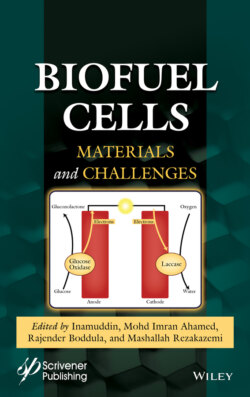Читать книгу Biofuel Cells - Группа авторов - Страница 25
1.5.2 Microorganism-Electrode Electron Transfer
ОглавлениеElectron transfer between microbial cells and solid materials has always occurred in the nature. This phenomenon was first investigated by the Lovley’s research group in microorganism-metal interactions, particularly species with Fe(III) reducing capability [152]. Electron transfer takes place in the cytoplasm of the cell for regular metabolic pathways. However, the phenomenon at the bacteria–electrode interface was differentiated and it named extracellular electron transfer (EET). EET is defined as the process in which the electrons derived from the oxidation of substrates, are transferred to the outer surface of the cell to reduce an extracellular terminal electron acceptor [153].
Similar to the classification of electron transfer phenomena already mentioned for enzymes, microbial EET has been grouped into direct (DET) and mediated transfer (MET) and is achieved by different structural molecules or via metabolites expelled by the cell. Table 1.3 shows a classification of the EET mechanisms recognized for electroactive bacteria.
DET involves a physical contact between components of the cell membrane and the electrode; in this case the contact is maintained by an exo-polymeric matrix surrounding the cells. In the cases when the biofilm is not formed, EET is lower in comparison to bacteria in biofilm.
Outer membrane cytochrome complexes are present in different forms and depend on the electroactive species. In Geobacter various multihaem cytochromes, and multi-copper proteins have been identified. In Shewanella, redox reaction cascades from six multi-haem cytochrome complexes, mediate the EET (Table 1.4).
Another DET mechanism is performed via pilus-like structures commonly named nanowires. These structures are observed in G. sulfurreducens and S. oneidensis. The appendages favor transfer of electrons through longer distances and even at a centimeter scale. EET between species has been described for anaerobic granules but this mechanism is also associated to interspecies EET in electroactive biofilms [160]. The proteins that participate in the electron transfer via pili-like structures are still being investigated; their identification presents difficulties because the bacteria produce a variety of filaments and not all of them seem to be conductive. The conductivity in the pili is attributed to the truncated PilA monomer; packed aromatic aminoacids form a path for conduction of electrons along the pili [161]. However, this mechanism seems not be predominant because only 80% of 95 species that have Fe(III) reducing capability lack electron-conducting pili genes [162].
Table 1.3 Mechanism for extracellular electron transfer at the interface microorganism-electrode. Direct electron transfer (DET), mediated electron transfer (MET).
| Extracellular electron transfer | |
| DET | MET |
| Membrane proteins | Primary metabolites |
| Pili structures | Secondary metabolites |
| Exo-polymeric matrix | Artificial redox mediators |
Table 1.4 Types of proteins involved in the EET in Geobacter sp. and Shewanella sp.
| Species | Type of protein | Location in the cell | Reference |
| Geobacter | ImcHCbcL | Cytoplasmic membrane | [154] |
| PpcAPpcD | Periplasm | [155] | |
| Omas | Form the trans-outer membrane protein complex with the porin-like outer membrane proteins. | [156] | |
| Omcs | |||
| OmbB | |||
| OmbC | |||
| Shewanella | CymA | Cytoplasmic membrane | [157] |
| Fcc3Small tetrahaem cytochrome | Periplasm | [158] | |
| MtrCBA | Outer membrane | [159] |
A mixed mechanism of EET comprises redox mediators embedded in the exo-polymeric matrix. The concentration and mobility of these molecules could contribute in some degree to the global electron transfer; however, this mechanism is not completely sustained by calculations of the electrical current produced from possible concentration of a mediator [163].
MET via metabolites depends not only on the microbial species but the physiological state, growth phase and environmental conditions in which the bacteria develops. Primary metabolites are directly related to the substrate oxidation. For instance, hydrogen is the most interesting metabolite in the internal and external electron transport chain due to its ubiquity. Secondary metabolites are produced with an additional consumption of energy, examples of secondary metabolites acting as mediators are pyocianine and 2-amino-3-carboxy-1,4-naphtoquinone. Early studies on MET utilized synthetic mediators such as anthraquinone-2,6-disulfonate to mimic natural mediators [164].
